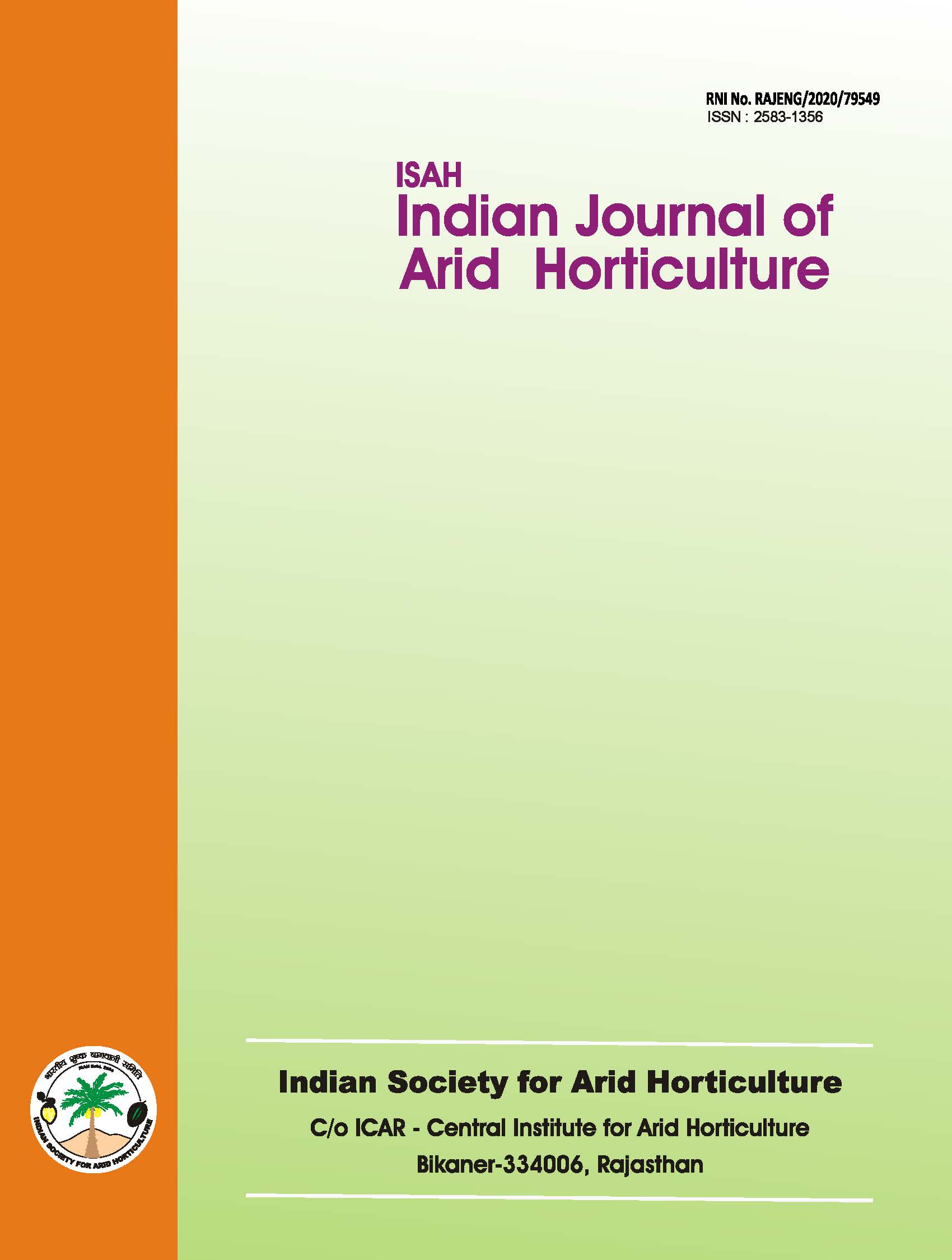Micropropagation and in-vitro conservation of elite geno- type of cactus pear (Opuntia ficus indica Mill.)
Keywords:
Micropropagation, in-vitro conservation, Cactus pearAbstract
Micropropagation techniques of cactus pear for a thorn-less, vegetable type elite genotype, which was collected under germplasm collection programmes, was developed successfully through single bud explant. Physiologically mature buds on cladodes were collected and single bud segment was used for culture initiation. Maximum multiple shoots (8 shoots/ explant) formation was achieved on MS medium supplemented with 30 g sucrose, 8 g agar and 2 mg 6- Benzylaminopurine (BA) 0.1 mg alpha-Naphthalene acetic acid (NAA) per liter. Multiple shoot clump were further subjected to culture for shoot elongation medium devoid of plant growth regulators. The elongated shoots were rooted cent per cent under in vitro conditions. The rooted plantlets were successfully acclimatized under three step hardening procedure. Under in vitro conservation study, in vitro rooted plantlets were used for further conservation by reducing growth of the plantlets and by minimizing sub-culturing process. The rooted plantlets were transferred on agar solidified MS medium supplemented with activated charcoal 3 g/l and different combinations of BA (0, 0.5, 1.0 mg/l) and NAA (0, 0.5, 1.0 mg/l). The higher concentration of BA (1.0 mg/l) was found to increase shoot proliferation and was detrimental to root growth of the in vitro plantlets whereas higher concentration of NAA (1.0 mg/l) was found to influence both shoot and root growth positively. This technique of in vitro conservation was found effective in maintaining cultures continue for more than six years. Further, proliferated growth of in vitro maintained plantlets were harvested and transferred to new containers for increasing number of stock materials.Downloads
References
Escobar, H.A., Villalobos, V.M., & Villegas, A. (1986). Opuntia micropropagation by axillary proliferation. Plant Cell, Tissue and Organ Culture, 7: 269-277.
Garcia-Sauceda, P.A., Valdez-Morales, M., Valverde, M.E., Cruz-Hernandez, A., & Paredes-Lopez, O. (2005). Plant regeneration of three Opuntia genotypes used as human food. Plant Cell, Tissue and Organ Culture, 80(2): 215-219.
Giusti, P., Vitti, D., Fiocchetti, F., Colla, G., Saccardo, F., & Tucci, M. (2002). In vitro propagation of three endangered cactus species. Scientia Horticulturae, 95(4): 319-332.
Johnson, J.M., & Emino, E.R. (1979). In vitro propagation of Mammillaria elongata. HortScience, 14(5): 605-606.
Juarez, M.C., & Passera, C.B. (2002). In vitro propagation of Opuntia ellisiana Griff. and acclimatization to field conditions. HortScience, 26(3): 315-321.
Johnson, J.L., & Emino, E.R. (1979). Tissue culture propagation in the Cactaceae. Cactus and Succulent Journal, 51(6): 275-277.
Khalafalla, M.M., Abdellatef, E., Ahmed, M.M., & Osman, M.G. (2007). Micropropagation of cactus (Opuntia ficus-indica) as a strategic tool to combat desertification in arid and semi-arid regions. International Journal of Sustainable Crop Production, 2(4): 1-8.
Malda, G., Suzan, H., & Backhaus, R. (1999). In vitro culture as a potential method for the conservation of endangered plants possessing crassulation acid metabolism. Scientia Horticulturae, 81: 71-87.
Mata-Rosas, M., Monroy-de-la-Rosa, M.A., Goldammer, K.M., & Chavez-Avila, V.M. (2000). Micropropagation of Turbinicarpus laui Glass et Foster, an endemic and endangered species. In Vitro Cellular and Developmental Biology – Plant, 37(3): 400-404.
Mauseth, J.D. (1979). A new method for the propagation of cacti: sterile culture of axillary buds. Journal of Cactus and Succulent, 51(4): 186-187.
Mohamed-Yasseen, Y., Barringer, S.A., Splitt-Stoesser, W.E., & Schnell, R.J. (1995). Rapid propagation of Opuntia ficus-indica and plant establishment in soil. Plant Cell, Tissue and Organ Culture, 42: 117-119.
Murashige, T., & Skoog, F. (1962). A revised medium for rapid growth and bioassays with tobacco tissue cultures. Physiologia Plantarum, 15: 473-497.
Nath, V., Singh, R.S., Shukla, A.K., & Vashishtha, B.B. (1999). Cactus pear (Opuntia ficus-indica Mill.) an emerging fruit crop for arid and semi-arid regions of India. Current Agriculture, 23: 49-58.
Nobel, P.S. (1995). Environmental biology. In: G. Barbera, P. Inglese, & E. Pimienta-Barrios (Eds.), Agro-ecology, Cultivation and Uses of Cactus Pear. FAO Plant Production and Protection Paper, pp. 36-48. Rome, Italy: FAO, 216 pp.
Pimienta, B.E., Barbera, G., & Inglese, P. (1993). Opuntia spp. (Cactaceae) International Network: An effort for productivity and environmental conservation for arid and semi-arid lands. Cactus and Succulent Journal, 65: 225-229.
Singh, D., Sivalingam, P.N., Bhargava, R., & Singh, R.S. (2009). Indian Journal of Arid Horticulture, 4(1): 20-25.
Preece, J.E., & Sutter, E.G. (1991). Acclimatization of micropropagated plants to greenhouse and field conditions. In: P.C. Debergh & R.H. Zimmerman (Eds.), Micropropagation Technology and Application, pp. 71-93. Boston: Kluwer Academic Publishers.
Rubluo, A., Marin-Hernandez, T., Duval, K., Vargas, A., & Marquez-Guzman, J. (2002). Auxin-induced morphogenetic responses in long-term in vitro subcultured Mammillaria san-angelensis Sanchez-Mejorada (Cactaceae). Scientia Horticulturae, 95: 341-349.
Sajid, G.M., Ilyas, M.K., & Anwar, R. (2006). Effect of diverse hormonal regimes on in vitro growth of grape germplasm. Pakistan Journal of Botany, 38(2): 385-391.
Vyskot, B., & Jára, Z. (1984). Clonal propagation of cacti through axillary buds in vitro. Journal of Horticultural Science, 59(3): 449-452.
Zeng, Z.C., Lu, L., & Baihong, C. (2003). Rapid propagation of cactus 'Milpa Alta' in vitro. Acta Horticulturae, 30(5): 609-611.

